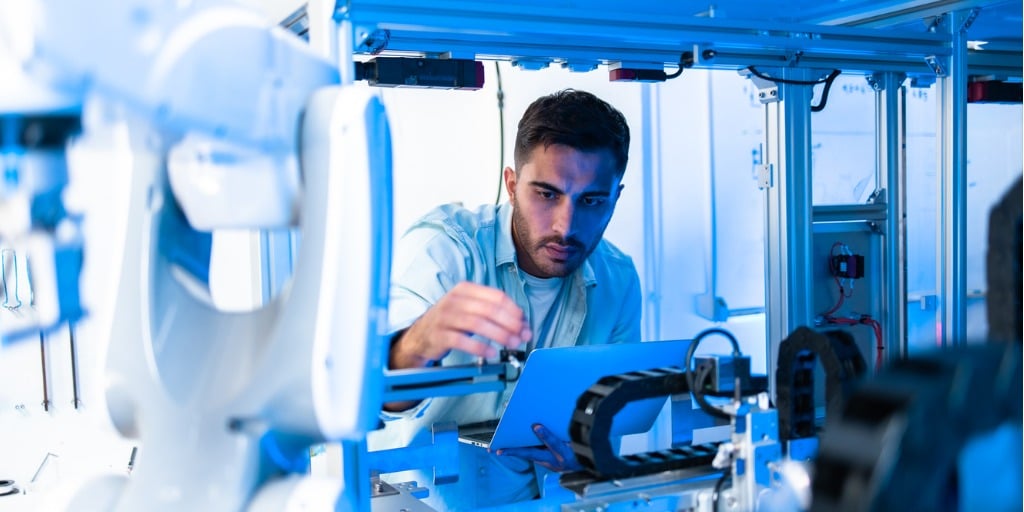In today’s evolving healthcare environment, advancements in technology are transforming the way biomedical equipment technicians support hospitals and medical facilities. These changes are creating both exciting opportunities and new challenges, as technicians are being asked to do more than ever.
Let’s explore how technology is influencing the demands on biomedical service professionals and what that means for the healthcare industry.
Time-Saving Tech vs Time-Consuming Tasks Associated with Biomedical Devices
As technology evolves, you would think it might save technicians time? Well, not always.
One surprising challenge biomedical professionals face is locating equipment. A study found that technicians spend 20% to 30% of their time simply looking for devices across sprawling healthcare facilities.
This is where asset tracking systems, such as RFID or real-time location systems (RTLS), come into play. These systems help track devices like portable ventilators and patient monitors through asset ID tags attached to the equipment. However, not every facility has adopted these technologies yet, leaving technicians chasing down equipment when they could be focusing on repairs or preventive maintenance.
When it comes to actual repair work, the balance of time varies. Many technicians report spending around 40% of their day on repairs and troubleshooting. The rest is dedicated to preventive maintenance, documentation, and coordinating with clinical staff to ensure devices are ready when needed.
![]() Click CHAT to speak with CME about how our Biomedical equipment technicians can help supplement in-house biomedical engineering departments.
Click CHAT to speak with CME about how our Biomedical equipment technicians can help supplement in-house biomedical engineering departments.
More Devices, More Responsibility for Biomedical Technicians
One of the biggest shifts in biomedical services is the sheer number of medical devices in use today. Decades ago, a technician might have been responsible for a couple of hundred devices. Today, that number has skyrocketed. On average, a single biomedical technician manages around 1,200 to 2,000 devices, depending on the size and type of facility.
From infusion pumps and patient monitors to surgical robots and imaging systems, the range of devices in service has grown exponentially. Each piece of equipment requires regular calibration, preventive maintenance, and repairs to ensure reliability, patient safety and compliance with regulations.
In 2019, the average hospital patient room contained 10 to 15 medical devices, depending on the level of care provided. This typically included:
- A patient monitor (for vital signs such as heart rate, blood pressure, and oxygen saturation).
- Infusion pumps for administering medications or fluids.
- A hospital bed with integrated controls.
- Oxygen delivery equipment.
- A portable suction machine.
- Basic diagnostic tools (e.g., thermometers or pulse oximeters).
In higher-acuity settings, like an intensive care unit (ICU), this number could rise to 20 to 25 devices, as ICUs often include additional specialized equipment such as ventilators and hemodynamic monitors.
As of 2024, the number of devices in a standard hospital patient room has increased to an average of 15 to 20 devices in general care rooms and 30 to 40 devices in ICUs. This jump is due to the integration of newer technologies and the growing role of connectivity in healthcare.
Here is what is now common in a patient room:
Connected Devices: Patient monitors, infusion pumps, and beds networked and integrated with the hospital’s Electronic Medical Record (EMR) system to provide real-time data.
Smart Infusion Pumps: Advanced pumps that adjust dosages based on EMR data or patient-specific factors.
Wearable Monitors: Devices tracking mobility, respiratory rates, or continuous ECG monitoring.
IoT Devices: Sensors that track room temperature, air quality, or equipment utilization.
Telemedicine Tools: Cameras and communication systems for remote patient consultations.
Automated Medication Dispensers: Systems to ensure accurate and timely medication administration.
In some cutting-edge hospitals, rooms are equipped with AI-powered devices for diagnostics, robotic assistants for tasks like lifting patients, and virtual reality systems for pain management or rehabilitation.
What’s Driving the Increase in biomedical devices?
Demand for Real-Time Data: Hospitals are prioritizing devices that feed real-time patient data into EMRs, to expedite decision-making and improve care coordination.
Focus on Patient Safety: Devices with built-in alarms, analytics, and safety features are being adopted to reduce medical errors.
Personalized Care: Advanced monitors and diagnostic tools allow for more tailored treatments based on a patient’s condition.
The Rise of IoMT (Internet of Medical Things): IoMT devices are becoming a standard part of healthcare infrastructure, linking medical equipment to hospital networks for seamless operation.
How IT and Biomedical Equipment Technicians Are Overlapping
In today’s healthcare environment, the lines between IT (Information Technology) and biomedical professionals are becoming increasingly blurred. As more medical devices integrate with hospital networks and Electronic Medical Records (EMRs), collaboration between these two departments is not only essential but inevitable.
Let’s explore how this overlap is shaping responsibilities and address the big question: who takes charge of repairing EMR-ready medical equipment?
Why IT and Clinical Engineering Are Converging
The convergence of IT and clinical engineering stems from the evolution of medical devices. Most medical equipment in use today, from infusion pumps to ventilators, includes software components, wireless connectivity, and the ability to interact with EMRs. This connectivity streamlines workflows and improves patient care but also introduces challenges related to:
Network Integration: Devices must connect securely to hospital networks and EMRs to upload patient data in real time.
Cybersecurity: Medical devices are now part of the hospital’s IT ecosystem, making them vulnerable to hacking or malware.
Data Management: BMETs need to understand how data flows from devices to EMRs, while IT teams must ensure the infrastructure supports these connections.
Examples of Overlapping Responsibilities
Here are some scenarios where IT and clinical engineering roles often overlap:
Troubleshooting Connectivity Issues:
If a patient monitor is not sending data to the EMR, IT may need to check the network, while BMETs inspect the device itself.
Cybersecurity for Medical Devices:
IT departments are responsible for ensuring network security, but BMETs often perform firmware updates to medical devices to address vulnerabilities.
Device Configuration and Software Management:
Configuring devices like infusion pumps to communicate with EMRs requires knowledge of both the device and hospital IT systems, necessitating collaboration between the two teams.
Who Repairs EMR-Ready Medical Equipment?
The responsibility for repairing EMR-ready medical equipment often depends on the nature of the issue:
Hardware Issues:
BMETs typically perform hardware repairs, such as fixing broken components, calibrating sensors, or replacing parts. For example: If an infusion pump’s motor fails, the BMET is responsible for diagnosing and repairing it.
Software Issues:
If the issue lies in the medical device’s software - such as a system crash, firmware bug, or incorrect configuration - the BMET usually takes the lead, though they might collaborate with IT for troubleshooting.
Connectivity Issues:
Problems with network communication or integration with the EMR usually require IT involvement. However, BMETs often assist by ensuring the device settings are correct. For example: If a vital signs monitor is not uploading data, IT may check the network, while BMETs verify the device’s software is compatible and properly configured.
Cybersecurity Incidents:
IT teams lead the charge in responding to breaches or vulnerabilities, but BMETs assist by implementing patches or isolating affected devices.
The Future of Biomedical Services
The demand for skilled biomedical technicians is only growing. With the rise of AI, IoT-enabled devices, and personalized medicine, the complexity of medical equipment will continue to increase. At the same time, technologies like predictive analytics and remote monitoring tools could help technicians anticipate equipment failures before they happen, shifting the focus toward more proactive service models.
While the need for BMET’s is steadily growing, industry publications are predicting a BMET shortage in the next ten years. According to a Becker’s Clinical Leadership article1, “A looming shortage of biomedical technicians and engineers, plus the closure of their programs, spells concern for the profession, according to the Association for the Advancement of Medical Instrumentation.” And, according to Jeremy Probst, president, and CEO of Technical Prospects, "As baby boomers continue to move towards retirement, we will begin to see an even greater talent shortage in healthcare technology management.” This, at a time when technology is advancing exponentially.
As hospitals adopt more advanced tools, the role of biomedical professionals will continue to expand - blurring the lines between engineering, IT, and clinical operations. For those passionate about problem-solving and technology, it’s an exciting time to be in this field.
What is clear is that while technology is changing the game, the core mission of biomedical services remains the same: ensuring that every device in the hospital works flawlessly to support patient care. And that is where partnering with CME can be invaluable.
Partner with CME for Biomedical Equipment Technicians
CME is not only the largest equipment-only specialty distributor of equipment used in healthcare but is also a reliable source for biomedical services.
CME Biomedical Equipment Technicians are available to compliment in-house resources during periods of biomedical staffing deficits.
Biomedical services have been at the heart of CME for over 45 years. With this expert experience we are ready to support your in-house biomed team.
Here is how:
- Meetings with your biomed staff to discuss hospital requirements for incoming inspections.
- Deliver, de-box, assemble, and install all equipment and remove trash.
- Document any failed equipment with hospital and manufacturer.
- Inventory and catalog all items by Asset ID#, Manufacturer, Model, SN, and location.
- Perform comprehensive equipment testing and electrical safety.
- Additional testing may include equipment functionality, battery functionality, scale calibration, preventive maintenance, performance verification, and output measurement testing.
- Attach asset ID tags and inspection result stickers according to hospital guidelines if needed.
- Provide all required documentation and equipment reporting for your CMMS.
CME start up biomed services guarantee that every device is tested and ready for service.
Our BMETs will also work with your facility to establish equipment maintenance plans designed to ensure the reliability of medical equipment and compliance with regulations.
![]() Click the CHAT button to start a conversation about your biomedical equipment needs.
Click the CHAT button to start a conversation about your biomedical equipment needs.
https://www.beckershospitalreview.com/patient-safety-outcomes/how-a-shortage-of-biomedical-technicians-could-affect-hospitals.html#:~:text=A%20looming%20shortage%20of%20biomedical,directly%20linked%20to%20patient%20safety.
About CME: CME Corp is the nation’s premier source for healthcare equipment, turnkey logistics, and biomedical services, representing 2 million+ products from more than 2,000 manufacturers. With two corporate offices and 35+ service centers, our mission is to help healthcare facilities nationwide reduce the cost of the equipment they purchase, make their equipment specification, delivery, installation, and maintenance processes more efficient, and help them seamlessly launch, renovate and expand on schedule.



